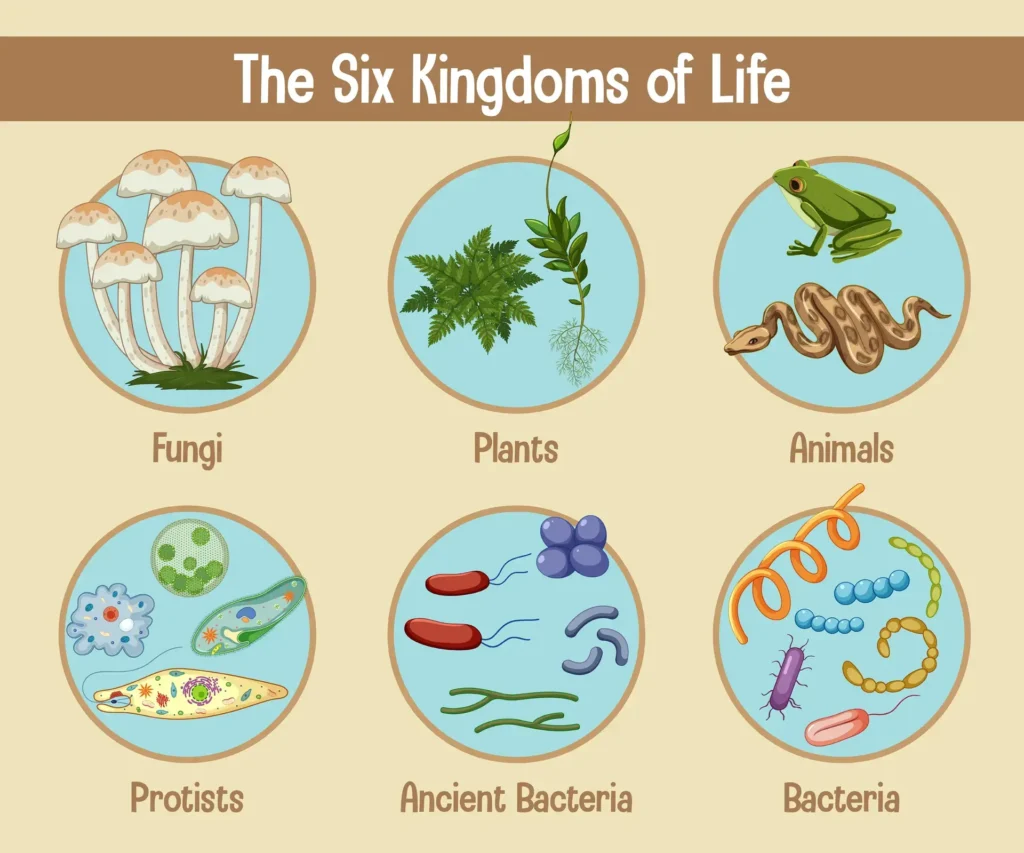The Six Kingdoms of Life
Life on Earth is incredibly diverse, ranging from tiny bacteria to complex organisms like plants and animals. To organize this diversity, scientists classify living organisms into categories based on shared characteristics. One of the most widely accepted systems is the Six Kingdoms of Life, which groups organisms into six distinct categories: Archaea, Bacteria, Protista, Fungi, Plantae, and Animalia. These kingdoms help scientists understand the relationships between different forms of life and the fundamental characteristics that distinguish each group.
1. Archaea
Archaea are single-celled microorganisms that are often found in extreme environments, such as hot springs, salt lakes, and deep-sea vents. They are classified as prokaryotes, meaning they lack a defined nucleus or membrane-bound organelles. Despite their similarities to bacteria, archaea have distinct genetic and biochemical differences.
- Characteristics:
- Prokaryotic cells (no nucleus).
- Live in extreme environments (extremophiles).
- Unique cell membranes and enzymes.
- Examples: Methanogens (produce methane), halophiles (salt-loving organisms), and thermophiles (heat-loving organisms).
Archaea play a crucial role in environments with extreme conditions, contributing to nutrient cycles and energy production.
2. Bacteria
Bacteria are also single-celled prokaryotic organisms, but unlike archaea, they inhabit a wide variety of environments, including soil, water, and the human body. These organisms are some of the most abundant organisms on Earth and play essential roles in processes such as decomposition, nitrogen fixation, and even digestion in humans.
- Characteristics:
- Prokaryotic cells.
- Found in diverse habitats.
- Some bacteria are beneficial, while others can cause disease.
- Examples: Escherichia coli (E. coli), Streptococcus, and Lactobacillus.
Bacteria are vital for the health of ecosystems and humans, providing essential functions in nutrient cycling and the production of food products like yogurt.
3. Protista
The Protista kingdom is incredibly diverse and includes both single-celled and simple multicellular organisms. Protists are eukaryotes, meaning they have a defined nucleus and membrane-bound organelles. They can be plant-like, animal-like, or fungus-like, and they live in aquatic or moist environments.
- Characteristics:
- Eukaryotic cells (with a nucleus).
- Can be autotrophic (photosynthetic) or heterotrophic (consume organic matter).
- Mostly live in water.
- Examples: Amoeba, Paramecium, algae, and slime molds.
Protists play an important role in aquatic ecosystems, where they serve as primary producers and consumers in the food chain.
4. Fungi
The Fungi kingdom includes organisms that are primarily decomposers, breaking down dead organic material and returning nutrients to the soil. Fungi can be unicellular, like yeast, or multicellular, like mushrooms. They are eukaryotic and have cell walls made of chitin.
- Characteristics:
- Eukaryotic cells.
- Heterotrophic (absorb nutrients from organic matter).
- Have cell walls made of chitin.
- Examples: Mushrooms, molds, yeasts.
Fungi are essential for nutrient cycling in ecosystems, and they have numerous practical uses, such as in the production of antibiotics and fermented foods.
5. Plantae
The Plantae kingdom consists of multicellular organisms that carry out photosynthesis, the process of converting sunlight into chemical energy. Plants are eukaryotic and have cell walls made of cellulose. They are autotrophic, meaning they produce their own food using sunlight, water, and carbon dioxide.
- Characteristics:
- Eukaryotic cells.
- Autotrophic (perform photosynthesis).
- Have cell walls made of cellulose.
- Examples: Trees, flowers, grasses, ferns, and mosses.
Plants are the primary producers in most ecosystems, providing food and oxygen for other organisms through photosynthesis.
6. Animalia
The Animalia kingdom includes all multicellular, eukaryotic organisms that are heterotrophic, meaning they consume organic material for energy. Animals lack cell walls and are capable of movement at some stage of their life. This kingdom is incredibly diverse, including everything from tiny insects to large mammals.
- Characteristics:
- Eukaryotic cells.
- Heterotrophic (consume organic matter).
- Lack cell walls and are capable of movement.
- Examples: Mammals, birds, reptiles, amphibians, fish, and insects.
Animals play various roles in ecosystems, from herbivores that consume plants to predators at the top of the food chain. They are integral to maintaining biodiversity and ecological balance.
The Importance of Classifying Life into Kingdoms
The classification of organisms into the six kingdoms helps scientists understand evolutionary relationships, identify species, and study the diversity of life. This system allows for a more organized approach to studying the similarities and differences between organisms, and it helps scientists trace how life on Earth has evolved over millions of years.
